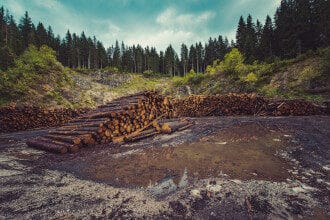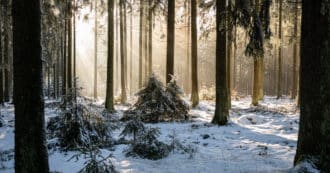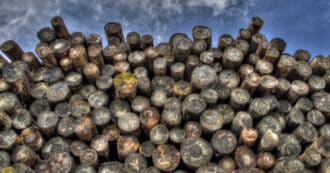By Harry Cooper – Boreal forests are some of the most important forests on the planet. Unlike deciduous and tropical forests, boreal forests are cold, coniferous forests that cover the top part of the northern hemisphere. The boreal forest extends throughout Scandinavia, Russia, Canada, and Alaska, and is one of the biggest forests in the world. Making up a third of all forested area on the planet, boreal forests can stretch for miles, spanning the length of entire continents.
The Forests of the North
Not only are these forests massive, but they are an important part in maintaining the arctic and global environment. The vast forests and tall trees support a diverse local wildlife habitat, as well as serving as an important stopping point for many migratory birds. In addition, the soil of boreal forests contains carbon rich permafrost that has been keeping greenhouse gases out of the atmosphere for thousands of years. While the boreal forests are a beautiful part of nature that provides numerous ecosystem services, human impacts have started to pose a huge threat to these northern forests.
The Boreal Ecosystem
By taking up such a vast amount of space, the boreal forest is capable of supporting a variety of different species. Home to many different species of mammals, birds, fish, insects, plants, and even a handful of reptiles and amphibians, the boreal forest holds a massive ecosystem, rich with biodiversity.
Vegetation in the Boreal Biome
The plant life in boreal forest ecosystems is mainly dominated by coniferous tree species such as white spruce, black spruce, jack pine, balsam fir, and tamarack. While these trees keep their needle-like leaves all year round, there are also a few deciduous trees that call the boreal forest their home, such as white birch and aspen trees.
These trees need to be adapted to the harsh cold winters of the boreal forests in order to survive. The coniferous trees maintain a narrow shape with little surface area. This decreased surface area prevents large amounts of snow from building up and breaking branches, as well as makes them resistant to harsh winds that would normally dry out less adapted tree species. Deciduous trees make sure to get all their energy from photosynthesizing in the spring and summer before shedding their leaves in the early fall to prevent snow build up from breaking their branches.
Other Types of Boreal Plants
The massive trees of the boreal forest take up most of the light and nutrients leaving the forest floor relatively empty of other plant life save for a few species of shrubs, moss, and lichen. While these other plants are not as dominate as the trademark coniferous trees, they are still very important to the boreal forest ecosystem. Many shrubs provide berries to birds, rodents, and other herbivores, while mosses and lichens blanket the forest floor keeping the soil cool and moist.
Wildlife in the Boreal Biome
Other than plants, the boreal region is home to a variety of animal species, including mammals, fish, birds, insects, reptiles, and amphibians. These boreal species all exist within a complex food web that makes up the boreal ecosystem. One of the more important animals in this ecosystem is snowshoe hare. These rabbits have white fur in the winter to camouflage against the snow cover, and brown fur in the summer, but regardless of their attempts to hide, they are one of the most prominent sources of food for predators such as wolves, lynxes, and birds of prey. While the snowshoe hares and other herbivores rely on the shrubs, leaves, and berries, predators higher up in the food chain require a steady population of prey in order to survive.
Birds in the Boreal Zone
Another type of animal that relies heavily on the boreal forests of North America are the thousands of migratory birds that come to the region every year. These boreal forests are colloquially known as North America’s bird nursery, this is because of the vast amount of bird species that rely on the boreal forest during their breeding season. A little over half of the bird species in North America migrate to the boreal forest during their breeding season. It is estimated that around three billion birds migrate to the boreal region each year, and around five billion return (including the offspring).
Although, while these forests are incredibly important for birds and other species, the boreal forests have come under threat from human activity such as deforestation and climate change. While organizations such as the boreal songbird initiative work to help protect the migratory birds that rely on the boreal forest, there is still a lot of work to be done to ensure that the boreal forest will survive.
Threats to the Boreal Forest
Permafrost is a type of soil that remains permanently frozen throughout the year. Near the surface of the permafrost are large quantities of organic matter that can’t decompose due to the cold temperatures, this makes permafrost ideal for storing carbon long term.
The Threat Caused by Climate Change
With almost one fourth of the northern hemisphere’s land mass covered in permafrost, the boreal forests are some of the most carbon rich ecosystems in the world. However, as climate is warming a lot of this permafrost is starting to melt, releasing large amounts of carbon into the atmosphere each year.
Climate change is one of the biggest threats to the boreal forest. Not only is the boreal forest warming three time faster than most parts of the world, causing an increase in forest fires and changing species distribution, but the warming of the forest is actually creating a very dangerous positive feedback loop.
Deforestation Threatens Boreal Forests
The massive logging industries of northern countries such as Canada and Russia have a huge impact on the destruction of the boreal forest. Canada, home to the largest intact portion of the boreal forest, has consistently boasted to being close to achieving net zero deforestation, but recent findings have shown that this is not the case. It is estimated that Canada cuts down nearly a million acres of forest a year, most of which is in the southern boreal forest of Ontario. This has made Canada one of the top three offenders of deforestation along with Brazil and Russia. This kind of industrial logging destroys essential habitats and releases massive amounts of carbon emissions from lost permafrost.
Religion and the Boreal Forest
Jennifer Lamson wrote for Pew about how Indigenous groups are playing a key role in protecting boreal forests. She describes how “Indigenous peoples who live in Canada’s boreal forest have been guardians of the region’s land and waters for millennia. Their stewardship and cultural perspective point the way toward a more sustainable future for all of us.” What can we learn from the indigenous approach to conservation? Let’s dive deeper to find out.
Lamson interviews Valérie Courtois, director of the Indigenous Leadership Initiative (ILI), whose description of the indigenous relationship with the land is inspiring, and yet painful to hear, because our Western society has yet to realize it’s obvious truth:
Indigenous peoples have a conservation ethic that is innate and is a very logical and natural thing. Without lands, there would be no Indigenous peoples. So that has translated into the whole spiritual relationship that Indigenous peoples have with their lands.
If you look at locations where First Nations [indigenous people of Canada] have control over lands, they have conserved well over 50 percent of those lands.
Imagine if we could conserve at least half as much land as we develop. Recognizing that our well-being is tied to the well-being of the land as indigenous people do, we would be well on our way towards a more sustainable future.
But the indigenous people have hope. We have been pushing our planet to the breaking point through greed and indifference, yet Courtois assures us, it is not too late:
There are prophecies within our culture that say that one day people of the world will look to First Nations in the boreal for solutions and protection from the impacts of bad decisions and destruction of lands. Not only do Indigenous people see a personal responsibility to the land, but we also feel a responsibility for everybody else.
May we soon see the day when this prophecy will come true, and indigenous people will lead us towards living in balance with our Mother Earth.
Today the boreal remains one of the largest intact forest ecosystems on Earth, in large part because of Indigenous communities guided by a conservation ethic rooted in traditional knowledge and science that has been passed down through generations. The cultural and spiritual lives of Indigenous people are intricately tied to the natural world they inhabit: The land and the people are the same.
Some of the biggest recent conservation gains in Canada have been achieved thanks to innovative land use planning by, and leadership of, Indigenous communities. Successes include protection of 6.4 million acres of boreal forest in the Thaidene Nene region of the Northwest Territories—in parks to be co-managed by the Dene community of Lutsel K’e—and creation of the 2.6 million-acre Mealy Mountains National Park on traditional Innu territory in Newfoundland and Labrador.
* Featured image source





